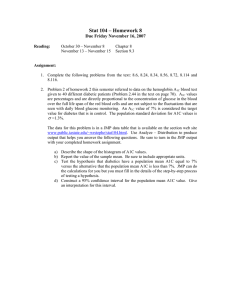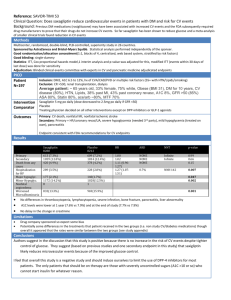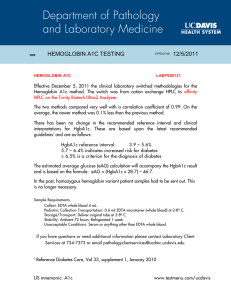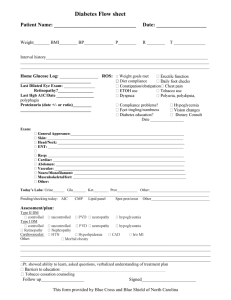Research Support Collaborators Background Strategies for Improving Chronic Disease Care
advertisement
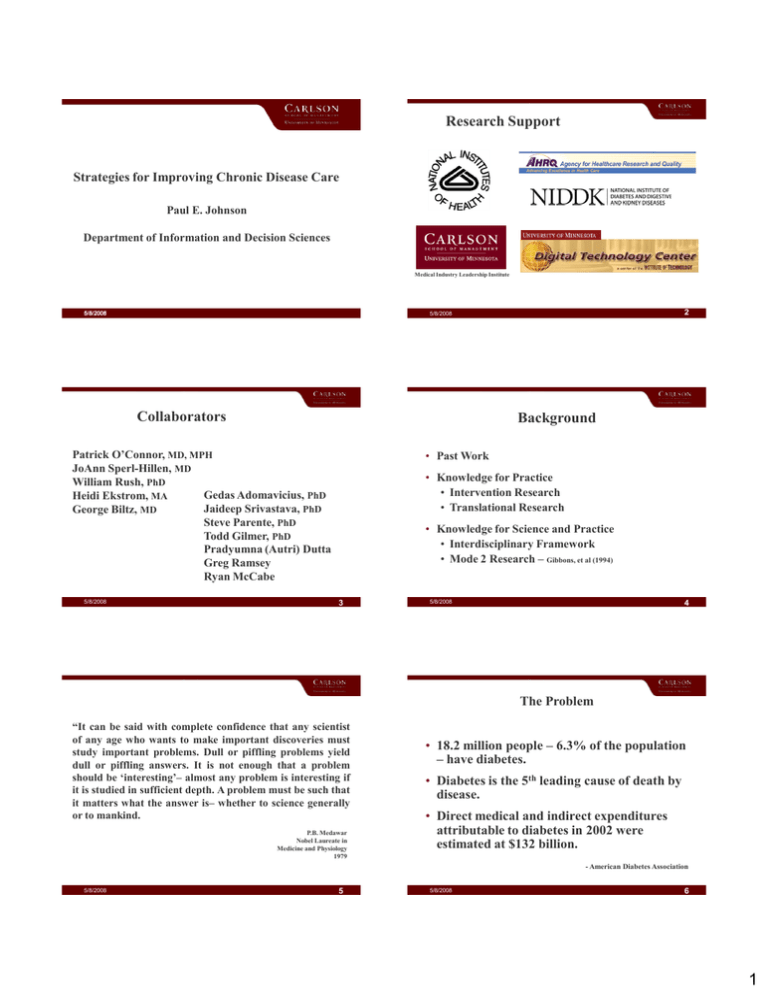
Research Support Strategies for Improving Chronic Disease Care Paul E. Johnson Department of Information and Decision Sciences Medical Industry Leadership Institute 5/8/2008 Collaborators Background Patrick O‟Connor, MD, MPH JoAnn Sperl-Hillen, MD William Rush, PhD Gedas Adomavicius, PhD Heidi Ekstrom, MA Jaideep Srivastava, PhD George Biltz, MD Steve Parente, PhD Todd Gilmer, PhD Pradyumna (Autri) Dutta Greg Ramsey Ryan McCabe 5/8/2008 2 5/8/2008 • Past Work • Knowledge for Practice • Intervention Research • Translational Research • Knowledge for Science and Practice • Interdisciplinary Framework • Mode 2 Research – Gibbons, et al (1994) 3 4 5/8/2008 The Problem “It can be said with complete confidence that any scientist of any age who wants to make important discoveries must study important problems. Dull or piffling problems yield dull or piffling answers. It is not enough that a problem should be „interesting‟– almost any problem is interesting if it is studied in sufficient depth. A problem must be such that it matters what the answer is– whether to science generally or to mankind. P.B. Medawar Nobel Laureate in Medicine and Physiology 1979 • 18.2 million people – 6.3% of the population – have diabetes. • Diabetes is the 5th leading cause of death by disease. • Direct medical and indirect expenditures attributable to diabetes in 2002 were estimated at $132 billion. - American Diabetes Association 5/8/2008 5 5/8/2008 6 1 More Diabetes Facts … the acute care paradigm is no longer adequate for a world, in which chronic illness is a major health challenge facing all countries. In the U.S. alone, the Centers for Disease Control and Prevention has recently estimated that chronic illness is responsible for 70 percent of all healthrelated deaths and 75 percent of all health care costs. The aging of the U.S. population and increases in risk factors such as obesity ensures that chronic illness will be an even greater problem in future years. • Approximately 65% of deaths among people with diabetes are due to heart disease and stroke. • Diabetes is the leading cause of new cases of blindness among adults 20-74 years old. • In most practice settings, only a minority of adults with diabetes have achieved evidencebased goals. Innovative Care for Chronic Conditions World Health Organization, 2002 - American Diabetes Association 77 5/8/2008 5/8/2008 8 Issues for Theory and Practice Strategies for More Effective Diabetes Care A = Expert B = Experienced Non-Expert A P5 • Question – Science / Practice B1 = Redesigned Non-Expert C = Consensus Guidelines B1 Power • Data – Lab / Field (Performance) D = RCT P4 C P3 B P2 • Simulation Tools D P1 • Testing – Practice / Policy G1 G2 Generality 9 5/8/2008 G3 Newell, A. (1990). Heuristic Programming: Ill Structured Problems. Progress in Operations Research, vol. 3. 10 5/8/2008 Role of Theory The Task • Medicine –Understanding the Task • Select evidence-based clinical goals • Decision Science and Organization Theory – Decision Making and Policy Practices • Initiate therapy • Titrate therapy to achieve goals • Cognitive Science – Explanation for Success and Failure / Methodology for Investigation 5/8/2008 • Assess and manage co-morbid conditions 11 5/8/2008 12 2 Background of Empirical Work Success and Failure in Chronic Disease Care • Modify Physician Decisions Through Case Based Learning-(SimCare Project- AHRQ) • Limited Experience (Lack of Expertise) • Personalized Information for Physicians and Patients - (Project MOVES - NIH) • Delay of Feedback • Modify Physician Decisions Through Personalized Case Based Learning and Real Time Decision Support- (Clinical Inertia Project-NIH) • Clinical Inertia • Cognitive Bias / “First Do No Harm” • Nature‟s Solution – A. Clark, 1998 13 5/8/2008 14 5/8/2008 Knowledge in a Low Base-Rate World Information Arbitrage • “The Lexus and the Olive Tree” • Knowledge Production Problem - Thomas Friedman • A Strategy of Knowledge Production • Knowledge Transfer Problem - Gibbons et al • Arbitrage: The Alternative Solution • A Strategy for Usable/Actionable Knowledge - Lindbloom & Cohen 15 5/8/2008 16 5/8/2008 The Personalization of Care Problem I Arbitrage for the Personalization of Care Patients P1 c a P2 c c c P3 c b c 17 5/8/2008 b P4 a a b P5 b b b Outcomes: 5/8/2008 Treatments II III a=optimal b=moderate c=weak 18 3 Ashby‟s Law of Requisite Variety* Some Example Patient Types (categories) for Type II Diabetes Treatments Patient Types I II III A b a C B a c b C c b a Outcomes: “Don‟t Worry Be Happy” “Walking Time Bomb” “Train Wreck” a=optimal b=moderate c=weak W.R. Ashby, (1956). Introduction to Cybernetics. 19 5/8/2008 5/8/2008 20 Record of Problem Solving Activity with Panel of Real Patient Cases Physician Problem Solver Decision Policies for a Low Base-Rate World 21 5/8/2008 22 5/8/2008 Record of Problem Solving Activity with Panel of Real Patient Cases Record of Problem Solving Activity with Panel of Real Patient Cases Physician Problem Solver Physician Problem Solver Record of Problem Solving Activity with Sample of Synthetic Patient Cases Record of Problem Solving Activity with Sample of Synthetic Patient Cases Models of Physician Problem Solvers Record of Problem Solving Activity on Population of Synthetic Patient Data 5/8/2008 23 5/8/2008 24 4 Patient Model - SimCare Patient Simulation - Record of Problem Solving Activity with Population of Real Patient Cases Physician Problem Solver Physician Record of Problem Solving Activity with Sample of Synthetic Patient Cases Record of Physician Treating Cases Simcare UI Patient Case Library Development of Prediction Tools Models of Physician Problem Solvers Patient Simulation Record of Problem Solving Activity on Population of Synthetic Patient Data 25 5/8/2008 SimCare‟s Core Functions 5/8/2008 26 Current SimCare/Clinical Inertia in DM Care Model - Functional Overview Diet & Exercise Sulfonylureas Metformin TZDs Therapeutic Goals HgbA1c Insulin Observable Patient States Weight Zoloft Clinical Encounters Fibrates Statins LDL Blood Pressure Smoking Aspirin Status HgbA1c BG BP LDL Depression Lifestyle Recommendations Adherence Cardizem Lisinopril Hydrochlorothiaz ide Atenolol Amlodipine Physician Actions Dose Response and Medications Time Effect Curves Medication Effects From Dutta, et. al., 2004, SimCare: A Simulation Model to Investigate Physician Decision-Making in the Care of Patients with Type 2 Diabetes, in Advances in Patient Safety: From Research to Implementation, K. Henriksen, Battles, J.B. & Lewin, D., Editors. 2004, AHRQ Patient Safety Research Coordinating Center: Rockville, MD. (In Press) 5/8/2008 27 5/8/2008 28 SimCare Patient Cases The SimCare Study • Case 1: Initiate & titrate oral medications to reach evidence- based goals • Case 2: Detect & treat depression, stop contraindicated metformin, adjust insulin once depression is treated 40 Physicians 3 Simulated Patients • Case 3: Recognize that metformin & glipizide are contraindicated, initiate & titrate insulin to reach evidence-based goal 5/8/2008 29 5/8/2008 30 5 Errors in the Treatment of Chronic Disease Health Outcome (A1c) vs. Cost vs. Frequency of Errors (Total) for Selected Physicians on Synthetic Patient 15 (Case 1) • Omission 2500 Failure to collect information Failure to start medication Failure to titrate to goal 10 1500 5 1000 500 • Commission 0 Contra indications 0 7.0 91 days 8 enctrs 7.3 120 days 8 enctrs 7.5 126 days 4 enctrs 7.5 309 days 9 enctrs 8.2 42 days 5 enctrs Total Cost=Pharmacy+Referral+Lab Test 31 5/8/2008 Omission Errors Cost ($) 2000 5/8/2008 8.3 360 days 6 enctrs Total Costs Errors 32 Physician Decision Making Methods Non-Expert Physician Decision Making as Process Control Expert Physician Process Process (Feedback) (Feedforward) Current A1c – Previous A1c 33 Inverse Problem • The environment changes, both autonomously and as a consequence of previous decisions 5/8/2008 34 Patient Response Treatment • Reasoning From Effects to Causes Patient Patient -- • The Default Strategy Patient Model Patient Model Rx Rx 5/8/2008 Decisions are Interdependent Solving the Inverse Problem Process Control for Type 2 Diabetes A 1c • More Frequent More Intensive Titration 5/8/2008 + + Series of Decisions Current A1c – Expected A1c Less Frequent Less Intensive Titration Goal • 0 0 5 5 AA 1c 1c 00 -1% -1% 10 10 -2% -2% 20 20 etc. etc Estimated Response -- + + • What the Expert Does Error 35 5/8/2008 36 6 Expert‟s Solution: Solving the Inverse Problem Distance to Goal X Current Treatment: No treatment Oral Medication Insulin Explaining Success • Process Control Treatment Move • The Patient Model • Solving the Inverse Problem Treatment needed to get the desired effect Distance to Goal 3 Current Medications No treatment 3 Oral med 3 Oral - max dose Treatment Move Start 2 oral medications Increase dose, introduce 2nd oral medication Start Insulin, adjust quickly 37 5/8/2008 38 5/8/2008 Decision Making as Process Control Explaining Failure Feed Forward D T E • Slips and Mistakes • Lack of Knowledge R • Inert Knowledge • Mind Bugs Feedback D T E R W.R. Ashby (1956). Introduction to Cybernetics 39 5/8/2008 40 5/8/2008 Feedback Strategy Feed Forward Strategy (Anchoring & Adjustment) • Determine Anchor (Goal or Desired Decrease in A1c) • Determine Distance to Goal • Determine Distance and Time to Achieve Goal • Select Move (Medication & Dose) • Select Move (Medication & Dose) • Determine Rate of Change (Slope) Needed to Achieve Goal • Compare Observed A1c with Anchor • Compare Observed & Expected A1c • Iterate to Goal 5/8/2008 • Iterate to Goal 41 5/8/2008 42 7 Comparison of Expert and Expert‟s Method on Synthetic Patient 15 Expert‟s Strategy 11 • Determine Distance & Time to Achieve Goal 10 • Determine Rate of Change (Slope) Needed to Achieve Goal A1c • Select Move (Medication & Dose) 9 Method Expert 8 • Compare Observed & Expected A1c 7 • Determine Adjustments in Slope Needed to Achieve Goal 6 5 • Iterate to Goal 0 100 200 300 400 500 Number of Treatment Days Elapsed 5/8/2008 43 5/8/2008 44 Performance of Physician Models on 13 Synthetic Patients Patient Characteristics (A1c) 7 < A1c < 12 Feedback Physician 4011 Effect of Physician Treatment Strategies on Populations of Simulated Patients Feedforward Physician 4018 5008 5005 4023 Expert 3 3 5 10 12 13 2 0 0 3 5 6 1 3 5 7 7 7 (13 total) A1c >9 (6 total) A1c <9 (7 total) 45 5/8/2008 5/8/2008 Treatment Strategies for Effective Diabetes Care Target Population of Simulated Patients (Number of Patients Per Cell Reflects Distribution in Real Patient Population) Initial A1c A1c > 10% Adherence High Low 458 Total Feedback 153 611 1678 8 < A1c < 10% 1394 284 A1c < 8% 6687 1024 7711 Total 8539 1461 10000 5/8/2008 46 47 Weak 5/8/2008 Strong Feedforward Weak Strong 48 8 Decision Rules Decision Rules (Far From Goal) (Near Goal A1c = 7.5) Monitor A1c level: increase meds when patient not at goal and A1c not decreasing Feedback Weak Monitor A1c level: increase meds when patient not at goal Feedback Strong Monitor Rate of Change (slope) in A1c level: increase meds and/or reduce time between visits to maintain minimum rate of reduction in A1c (e.g., 0.5% per month*) Monitor Change in Slope: increase meds and/or reduce time between visits to maintain minimum rate of reduction in A1c to meet time goal (e.g., 1 yr.) Increase dose when A1c has stopped decreasing (Nature‟s Solution) Feedback Strong Feedforward Weak Increase dose when Avg. SMBG has stopped decreasing (Nature‟s Solution) Feedforward Strong Increase dose when A1c above goal (Org. scaffolding) 5/8/2008 49 Expert 50 Effect of 1 Year of Treatment by Models, Physicians and Clinical Guidelines (Maintaining Goal) Feedback Weak Effect of 1 Year of Treatment Initial A1c > 10% N= 611 for Models, N= 438 for Physicians 12 Feedback Strong 11 Average A1c (%) Increase dose when prior avg. SMBG above goal and avg. SMBG values have upward slope. Feedforward Strong 5/8/2008 Decision Rules Increase med dose when A1c or avg. SMBG above “recidivism threshold” Feedforward Weak Increase dose when A1c above goal & prescribed meds estimated insufficient to reach goal (adding dose response curves) Expert *compute as monthly decrease in A1c required to reach goal within a specified period of time, e.g., 1 yr. Increase med dose when A1c above “recidivism threshold” Feedback Weak Feedforward Weak Feedforward Strong FBW 10 FBS FFW 9 FFS P HP 8 Guidelines 7 6 Expert 0 1 Years in Treatment A1c Recidivism threshold = 7.5% SMBG Recidivism threshold = 165 mg/dL * Staged Diabetes Mgmt (SDM) Guidelines, 2005. 5/8/2008 51 52 5/8/2008 Effect of Treatment Strategies over Time Effect of 1 Year of Treatment by Models, Physicians and Clinical Guidelines N= 611 Average A1c (%) Average A1c Average A1c (%) N= 1687 for Models, N= 1207 for Physicians P Initial A1c > 10% 12 11 FBW 10 FBS 9 FFW FFS 8 Guidelines 7 6 0 1 2 in Treatment 3 Years 4 Years in Treatment 5/8/2008 53 5/8/2008 54 9 Treatment Strategies and Variation in Patient State Cost to Bring Patients to A1c Goal - Year 1 (Initial A1c Values > 10%) (Average A1c Value in Bars) Strategy Standard Deviation of A1c N= 611 Pt Type (# Pts) $ % of Pts at Goal PMPM FBW 88 186 FBS 95 179 100 180 FFW LH (6687) FFS 100 EXP 100 192 FBW 11 2822 FBS 43 831 FFW MH (1394) 191 76 509 FFS 94 504 EXP 98 502 PMPM = Per Member Per Month FBW FBS 55 5/8/2008 % of Pts @ Goal 95 712 FBS 100 542 100 718 FFS 100 548 EXP 100 553 FBW 41 3958 FBS 84 2230 LH (6687) MH (1394) 95 3492 FFS 100 2355 EXP 100 2206 FBW 2 33146 FBS 30 5234 67 3216 FFS 95 2877 EXP 99 2960 FFW FFW HH (458) 5/8/2008 PMPM = Per Member Per Month 2 13184 3 12266 2 17217 9 3803 EXP 9 4147 FBW 42 1558 FBS 36 2014 12 6492 FFS FFW MH (1394) FFS 10 8689 EXP 8 10936 FBW 67 1073 FBS 83 1146 70 1528 FFW 5/8/2008 HH (458) Pt Type (# Pts) $ % of Pts with 0.5% Change PMPM FBW 6 2807 FBS 10 1745 13 1410 FFS 16 1160 EXP 17 1140 FBW 63 503 FBS 86 419 LH (6687) MH (1394) 96 407 FFS 96 494 EXP 97 507 FBW 74 466 FBS 91 458 98 474 FFS 100 663 EXP 100 767 FFW HH (458) PMPM = Per Member Per Month 5/8/2008 58 Personalization: Exploiting Variety PMPM FBS LH (6687) 56 $ % of Pts with 0.5% Change FBW FFW 821 FFW Cost to Reduce A1c by 0.5% - Year 2 Pt Type (#Pts) 1014 93 FFW 57 Strategy 65 EXP Strategy PMPM FBW FFW 3094 FFS Cost to Reduce A1c by 0.5% - Year 1 $ Pt Type (# Pts) 14660 HH (458) 5/8/2008 Cost to Bring Patients to A1c Goal - Year 2 Strategy 3 15 FFW Treatment Strategy FFS 28 4863 EXP 8 18827 • Use predictive models to match patients and physicians PMPM = Per Member Per Month 59 • Types of predictive models • Statistical (e.g., UKPDS risk engine) • Machine Learning (e.g., decision tree) 5/8/2008 60 10 Experiment: Switch Patients to Low Cost FBW Strategy for Maintenance • Experiment: Number of Patients at Goal by Year 1 Treat patients A1c > 10% and A1c < 8% with FBS, FFW, FFS, Expert strategies for 1 year Strategy FBS FFW • Pt Type (# pts) FFS For all patients that reached goal at end of 1 year: • maintain by using existing strategies • maintain by switching to FBW strategy 6344 LH (6687) 6686 13 HH (458) EXP Experiment: Cost to Treat Year 2 Pt Type (# pts) 428 62 Cost Savings Associated with Switching Treatment Strategies in Year 2 Avg Monthly Cost to Maintain Tracked Pts Initial Strategy (# pts at goal) Maintained by FBW Strategy ($) FBS 312 301 FFW (6666) FFW 331 325 FFS (6682) LH (6687) 69 299 5/8/2008 Maintained by Initiating Strategy ($) Strategy 6682 FBS FFW 61 6666 EXP FFS 5/8/2008 Pt Count Pt Type (# pts) FBS (6344) Cost* Savings per Year ($) when switched to FBW Strategy 837,408 LH (6687) 479,952 1,202,760 354 339 EXP (6686) EXP 355 340 FBS (13) 780 FBS 1083 1078 FFW (69) 1,656 1097 1095 FFS (299) 1234 1232 EXP (428) 1443 1448 FFS FFW FFS EXP HH (458) 5/8/2008 1,203,480 HH (458) 7,176 (25,680) *Cost = Cost of year 2 treatment for tracked patients minus cost of year 2 treatments for those same pts when tested in year 2 with FBW strategy. 63 5/8/2008 64 The UKPDS (Prospective Diabetes Study) Risk Engine* • Model for predicting absolute risk of CHD • Based on RCT of 4540 newly diagnosed Type 2 diabetes patients followed for 10 years. The Problem of Risk • Independent variables: age, gender, ethnicity, smoking, A1c, SBP, cholesterol • Statistical model composed of survival probability equations *Stevens et al., (2001). The UKPDS risk engine: a model for the risk of coronary heart Disease in Type II diabetes (UKPDS 56). Clinical Science, 101:671-679. 5/8/2008 65 5/8/2008 66 11 Risk of Coronary Heart Disease (CHD): 1 Year of Treatment Strategy Pt. Type (# pts) CHD Event Fatal CHD Untreated 22 18 FBW 20 16 FBS 19 15 FFW 19 15 FFS 19 15 EXP 19 15 Untreated 29 24 FBW 23 19 FBS 21 17 FFW 19 15 FFS 18 15 EXP 18 15 Untreated 42 37 FBW 32 28 FBS Best Practice Strategies: Low Risk (of CHD) and Lowest (PMPM) Cost % Risk of Adverse Event within 10 Yrs LH (6687) MH (1394) 30 25 FFW 23 19 FFS 19 15 EXP 19 15 HH (458) • A1c < 8% – Expert • A1c between 8% and 10% – Feedforward Weak • A1c > 10% – Feedback Strong 5/8/2008 67 Explaining Best Practice Strategies 5/8/2008 68 Issues for Requisite Variety in the Treatment of Chronic Illness • A1c < 8%: Expert – makes more moves than other strategies, identifies patients for moves via slope and level of average SMBG. • Regulation (with Respect Patient Categories) • A1c between 8% and 10%: Feedforward Weak –Makes more moves than feedback models because of scheduling practices (higher # patients with 0.5% decrease) and fewer than other feedforward models (lower cost than these models) because of smooth landing rule. • Personalization (with Respect to outcome, cost, risk) • Converting Theory into Practice • A1c > 10%: Feedback Strong – This strategy has lower costs because it starts fewer patients on insulin (compared to oral meds insulin is costly) 5/8/2008 69 Issues for Theory and Practice 5/8/2008 70 Summary and Conclusions A = Expert B = Experienced Non-Expert A P5 B1 = Redesigned Non-Expert C = Consensus Guidelines B1 Power (Performance) D = RCT P4 C P3 • Personalization of Care •Explanatory vs Predictive Modeling •Changing Practice- Training vs Decision Support •Redesign of Treatment Policies B P2 D P1 G1 G2 G3 • Unsolved Problems Generality 5/8/2008 • Modeling for Decision Making & Treatment Outcomes •Comparative Effectiveness Studies •Prioritization of Care •Policy Development 71 5/8/2008 72 12 The Way Forward … To address the rising rates of chronic conditions, an evolution in health care systems is imperative. Acute care will always be necessary (even chronic conditions have acute episodes), but at the same time health care systems must embrace the concept of caring for longterm health problems. It remains to be seen whether work that combines knowledge from fields as diverse as computer science, decision making and the management of clinical care, can contribute to the development of such concepts. Patients, health care organizations and decisionmakers have to recognize the need to expand systems to include new concepts… But as Sherlock Holmes said to Watson “… the game is afoot…” Innovative Care for Chronic Conditions World Health Organization, 2002 5/8/2008 73 5/8/2008 74 13

